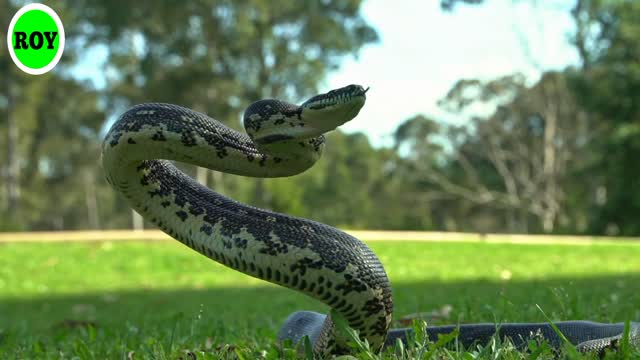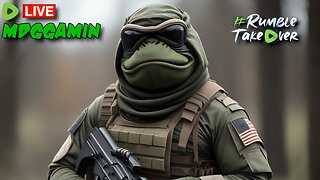Premium Only Content

Watch the video of the venomous snakes in the forest
Sea snakes are also highly venomous.
There are 23 types of sea snakes in Bangladesh, they bite the fishermen who go to sea for fishing.
However, due to their location deep in the ocean, the incidence of snake bites is usually rare.
He said that four times as many people die of snake bites in Bangladesh, various mutilations occur, some become physically crippled, and some suffer long-term mental trauma.
According to the Bangladesh Toxicology Society, seven species of venomous snake bites kill more people:
1. Naya Naya
It is a cobra or Gokhra species of snake, its scientific name is Naya Naya.
It is a terrestrial snake, it makes a hood and its hood has two spectacle-like rings.
BBC Bangla Other News:
US diplomats leave Chinese consulate
Nepalis claim their land by burying concrete poles on the Indian border
Experience of Bangladeshi Rahat Ahmed taking experimental vaccine
The formality and direction of the sacrifice has changed in the western part of the country, i.e. towards the Rajshahi region.
2. Naya Kauchia
It is also a species of Gokhra species, locally it is also called a species of snake or a species of snake.
This snake is also called Jura. This snake makes a hood.
It is mainly found in the eastern part of the country i.e. Sylhet, Noakhali area.
The number of snake bites in the country is the highest.
3. King cobra or conch
It is also called Raj Gokhra.
This horrible venomous conch is much taller in shape than other gokhras.
Its hood does not have spectacles like other gokhras.
Conch shells are more common in Bangladesh, Bhutan, Burma, Cambodia, China, India, Indonesia, Nepal, Philippines, Singapore, Thailand. This snake prefers to live in dense forests and hilly areas.
4. Crete or conch
This snake is also called Shankhini and Shankini snake.
There are a total of 6 species of snakes in the world, of which 5 species are found in Bangladesh.
This cretaceous snake is also locally called keute.
These snakes live in dry places around the house or in the woods.
5. Black Niger
It is also a species of snake and there are many snakes in Bangladesh.
It is more common in hilly areas of Chittagong and Sylhet, Noakhali and Sundarbans.
. Chandrabora or Russell's Viper
Another name of Chandrabora is Ulubora.
It is one of the most venomous snakes found in Bangladesh.
This snake became almost extinct from Bangladesh about a hundred years ago, meaning that not a single one of its snakes has been seen in decades.
But since the last 10/12 years, there has been evidence of snake bites again.
Fayez, a professor at the Toxicology Society, said that although there was evidence of the snake's existence in the Rajshahi region at first, it is now increasingly seen in the Faridpur region.
But research is now underway in Bangladesh on why and how this snake suddenly came back.
When this snake bites, the nerves become numb and blood clots form.
. Green bora
The Green Bora or Green Viper Snake is also locally known as Cheek Taua Snake.
This is the name given to the thick part of the head. A total of six species of this species are found in Bangladesh.
This snake lives in the forests of the Sundarbans and hilly areas, so it bites people on the face, head and body. Its sting causes bleeding in the nerves and muscles, and severe trauma to the brain.
Remedy for snake bites
There is a common misconception that people will die if they are bitten by a snake. Aniruddha Ghosh, a professor at Chittagong Medical College Hospital, told the BBC that 80 per cent of snake bites in Bangladesh are non-venomous.
As a result, the idea that a snake bites to death is not correct.
However, if the snake bites, snake bite medicine or antivenom should be applied as soon as possible. Then it is possible to prevent death.
According to the Bangladesh Department of Health, the antivenom used in the country comes mainly from Tamil Nadu, India.
Line Director of the Department of Non-Communicable Diseases. Habibur Rahman told the BBC that a little more than Rs 5 crore worth of antivenom is imported into the country every year under government management.
However, this antivenum is criticized as 'inappropriate' and 'unnecessary'.
Fayez, a professor at the Toxicology Society, says the antivenom brought to Bangladesh is basically a 'cocktail' or mixture of the venom of four snakes, which works to cure some snake bites.
In the rest of the case, they work partially. This is not at all fair. They make their antivenom with the venom of the local snakes of Tamil Nadu.
There is a difference between snake venom and snake venom in our country. Only 20 percent of the antivenom imported from India matches the snakes of Bangladesh. "
In this regard, the World Health Organization has instructed that people who have been bitten by snakes should be treated by making antivenom from local snakes. Otherwise it is not effective.
However, despite the high incidence of snake bites during floods each year, Antivenom is still found only in district towns, medical college hospitals and Sadar hospitals.
Supplies are made at the upazila level according to need and demand.
What to do if bitten by a snake?
Aniruddha Ghosh, a professor at Chittagong Medical College Hospital who researched snake bites and antivenom, said that one should know what to do with a snake bite and what not to do with it.
His advice is ---
What to do
* Seek medical attention immediately
* If you break an arm or a leg, just as it is lightly obstructed with a cloth with something hard, bind it in the same way
* Move the snake-cut muscle as little as possible, the less the muscle movement, the less venom will spread.
What not to do
* Can't panic
* Do not waste time waiting for witchcraft or scrubbing
* Do not eat anything until you see a doctor
* No ointment or massage should be applied
* Tightly tied to the place where the snake bites, because the blood can clot and the infected person can become paralyzed.
-
 38:22
38:22
Stephen Gardner
15 hours ago🔥HOLD ON! The RUMORS about Kamala are TRUE...
179K504 -
 1:22:44
1:22:44
Michael Franzese
1 day agoWill Trump’s Win Finally Convince Democrats to Stop The Woke Nonsense??
166K132 -
 8:27:07
8:27:07
MDGgamin
18 hours ago🔴LIVE- Rumble Gaming To The MOON - Variety of Games & Chatting - #RumbleTakeover
146K5 -
 27:24
27:24
Mr. Build It
5 days agoDECK DISASTER! How We Fixed a Botched Build
112K16 -
 26:58
26:58
barstoolsports
19 hours agoZach Bryan Blocks All of Barstool | Stool Scenes
123K17 -
 1:06:44
1:06:44
Talk Nerdy 2 Us
1 day ago🔥 Hackers vs. The World: From Amazon breaches to FBI-confirmed Chinese telecom spying
114K22 -
 1:24:20
1:24:20
Vigilant News Network
1 day agoJoe Rogan Drops Shocking Election Claim | The Daily Dose
175K199 -
 1:10:18
1:10:18
FamilyFriendlyGaming
1 day ago $19.43 earnedCat Quest III Episode 2
142K -
 20:07
20:07
DeVory Darkins
1 day ago $24.37 earned"They Talking About Finance!" The View FRUSTRATED by NYC Mayor TRUTH BOMB
107K123 -
 1:20:18
1:20:18
Steve-O's Wild Ride! Podcast
2 days ago $13.48 earnedThe Hawk Tuah Girl Is Really Becoming Successful! - Wild Ride #243
81.4K12